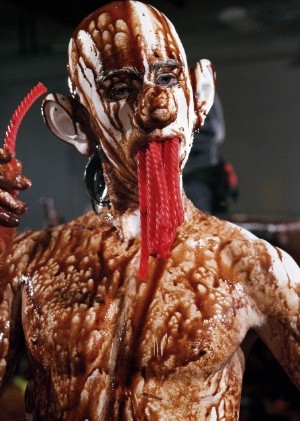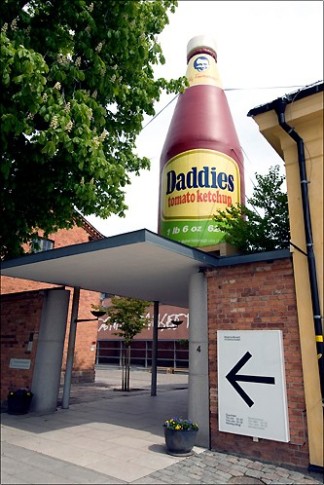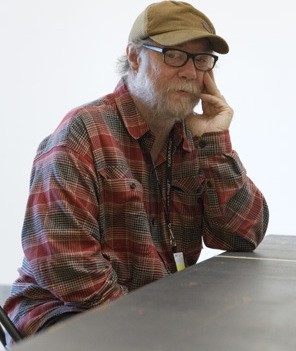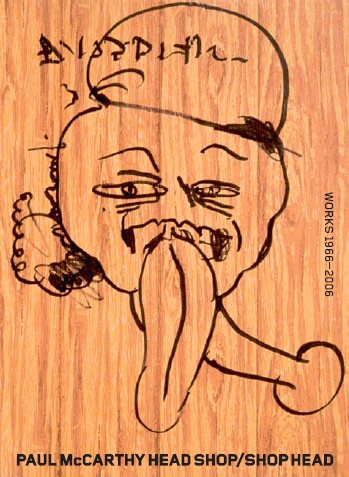
Paul McCarthy, Santa Chocolate Shop, 1997 Courtesy Hauser & Wirth Zürich London. Video.
Paul McCarthy
Head Shop/Shop Head
17.6 2006 – 3.9 2006
Stockholm
Paul McCarthy’s works are intrusive, frightening and beyond rhyme and reason. It is hard not to be emotionally affected by them. This summer, Moderna Museet will present this now world-famous provocateur, whose bountiful, complex installations level harsh criticism against the American Dream, consumerism, insipidness, hypocrisy – often with burlesque humour. This exhibition is a unique opportunity to study one of the greatest artist oeuvres, stretching from the 1960 until today. The mega-project Caribbean Pirates (2001–2005) will be one of the main attractions.
You may understand my actions as vented culture. You may understand my action as vented fear.
The fact that Paul McCarthy’s work is controversial and radical is probably not the only reason why it took so long for him to be recognised by major museums and galleries in the USA. For many years, most of his work focused on performance, which, on account of its transient nature, did not feature to any great extent in the art institutions. Today, he is a recognised and firmly established artist, both in Europe and the USA. In Sweden, however, only a few video works by the artist have been shown previously.
Many motifs and themes recur throughout Paul McCarthy’s entire body of work. For this exhibition he has realised works based on ideas he has collected since the 1960s. This repetition and recycling reflects an open approach to his own works. They are in a state of transformation.
McCarthy sees painting as being intimately associated with performance, and several of his early works which were photographed or videotaped feature McCarthy in the role of action painter, slithering across the floor with a can of white paint in front of him so he drags his body through the paint, or dipping his penis in paint and smearing it on a windshield, in a parody of Jackson Pollock or Yves Klein. And the liquids he uses in his performance – paint, ketchup, lubricants – symbolise body effluents.
Several of his earlier works make obvious reference to minimalism, and on the theoretical level these references permeate his entire production. The most famous example of this is Dead H (1968), featured in the exhibition. This galvanised steel sculpture in the shape of the letter H (for Human), is open at both ends so viewers can bend down and peer into and through it. McCarthy also uses the minimalist cube shape, imbuing it with references to the human body.
Physical challenges and situations where he loses control are a pervasive theme in McCarthy’s oeuvre. The loss of control is obvious in most of his filmed performances from the 1970. McCarthy appears to be out of his mind in many of the videos where he acts hysterical, comical and pathetic, but where his behaviour at any moment can turn into something dangerous, as with alcoholic, abusive men.
In 1983, McCarthy stopped doing live performances. Even if his previous performances sometimes only had a small audience, and although he continued to film his staged works that resemble performances, this was nevertheless a pivotal decision. McCarthy also replaced himself with moving sculptures.
The first moving sculpture was Bavarian Kick (1987). Two angular figures with legs made of iron piping, round balls for heads and equally round, red clown noses, are mounted on a pedestal that houses the mechanism. Both are dressed in Lederhosen and each holds a large beer mug raised in cheer. Later sculptures are more technically complex, sometimes incorporating technology and special effects used in the Hollywood and Disney film industries. The Garden (1992), for instance, includes sets from the 1960s Bonanza TV serial.
In the early 1990s, McCarthy created a number of sculptures with an aesthetic rooted firmly in pop art. Many of these works resemble over-grown toys or teddy bears, but in true McCarthyesque style they are twisted parodies of apparently innocent, cute playthings. Spaghetti Man is a rabbit with a boy’s body and a long, soft rubber penis that lies in coils on the floor. McCarthy demonstrates an obsession with the penis, from his early performances to his sculptures and video works. But the penis is never erect, and in the sculptures it is always detachable. Maleness is exposed as pathetic rather than macho and heroic.
Curator: Magnus af Petersens
On tour
ARoS Aarhus Kunstmuseum, Denmark
3 February – 6 May 2007
S.M.A.K., Stedelijk Museum voor Actuele Kunst, Ghent
12 October 2007 – 17 February 2008




